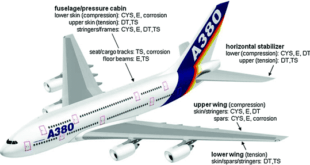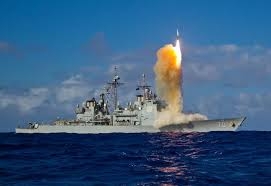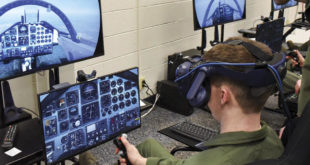An amphibious aircraft or amphibian is an aircraft that can take off and land on both land and water. Amphibious aircraft are heavier and slower, more complex and more expensive to purchase and operate than comparable landplanes but are also more versatile.
Amphibious aircraft can be much faster and have longer range than comparable helicopters, and can achieve nearly the range of land based aircraft, as an airplane’s wing is more efficient than a helicopter’s lifting rotor. This makes an amphibious aircraft, such as the Grumman Albatross and the Shin Meiwa US-2, useful for long-range air-sea rescue tasks. In addition, amphibious aircraft are particularly useful as “Bushplanes” engaging in light transport in remote areas, where they are required to operate not only from airstrips, but also from lakes and rivers.
China successfully tested its first domestically built amphibious aircraft ( AG 600, codenamed Kunlong ) with a series of water taxing and low-flight trials. Designed and built in China by the Aviation Industry Corporation of China (AVIC), the AG600 is reportedly set to be the largest amphibious aircraft in the world, roughly the size of a Boeing 737. When full operational , the AG600 would shift the balance of power in the disputed region with its ability to quickly transport troops and supplies, as well as provide other support, such as shifting garrisons in the south china sea. The aircraft can also be used to support foreign vessels for search and rescue missions.
DARPA has launched the Liberty Lifter project in May 2022 to demonstrate a leap in operational logistics capabilities by designing, building, and flying a long-range, low-cost X-plane capable of seaborne strategic and tactical lift. The new vehicle concept seeks to expand upon existing cargo aircraft by proving revolutionary heavy air lift abilities from the sea.
Although current sealift is very efficient in transporting large amounts of payload, it is vulnerable to threats, requires functional ports, and results in long transit times. Traditional airlift is much faster, but has limited ability to support maritime operations. Additionally, today, such aircraft suffer payload limitations or require long runways.
The envisioned plane will combine fast and flexible strategic lift of very large, heavy loads with the ability to take off/land in water. Its structure will enable both highly controlled flight close to turbulent water surfaces and sustained flight at mid-altitudes. In addition, the plane will be built with a low-cost design and construction philosophy.
There is a history of attempting to develop aircraft created to fly with “wing-in-ground effect,” which means the aircraft is flying no more than the length of its wingspan above ground or water. The most well-known examples are the Soviet “ekranoplans.” These vehicles were high speed and runway- independent, but were restricted to calm waters and had limited maneuverability.
“This first phase of the Liberty Lifter program will define the unique seaplane’s range, payloads, and other parameters,” said Alexander Walan, a program manager in DARPA’s Tactical Technology Office. “Innovative advances envisioned by this new DARPA program will showcase an X-plane demonstrator that offers warfighters new capabilities during extended maritime operations.”
To address the shortcomings of existing vehicles and operational concepts, the Liberty Lifter program focuses on addressing three main challenges.
Extended Maritime Operations: Emphasis will be placed on operating in turbulent sea states by creating high-lift abilities at low speeds to reduce wave impact load during takeoff/landing, and innovative design solutions to absorb wave forces. In addition, the project will address risks of vehicle collision during high-speed operation in congested environments. Finally, the aim is for the vehicle to operate at sea for weeks at a time without land-based maintenance activities.
Full-Scale Affordable Production: Construction will prioritize low-cost, easy-to-fabricate designs over exquisite, low-weight concepts. Materials should be more affordable than those in traditional aircraft manufacturing and available to be purchased in large quantities.
Complex Flight and Sea Surface Controls: Advanced sensors and control schemes will be developed to avoid large waves and to handle aero/hydro-dynamic interactions during takeoff/landing.
DARPA awards General Atomics
The Defense Advanced Research Projects Agency (DARPA) has signed a contract with General Atomics to develop a ground-effect cargo seaplane concept. Dubbed the Liberty Lifter, the project was announced in May 2022 and is intended to fly both as a regular seaplane and utilize the ground effect for more efficient transportation. The $7,967,144 cost-plus-fixed-fee contract, announced on November 25, 2022, is estimated to end in May 2023.
For the Liberty Lifter project, General Atomics will focus on designing a seaplane with extended maritime operations in high sea states that is affordable to produce, and that involves complex flight and sea surface controls.
General Atomics will try to achieve smooth flight while flying over waves as high as eight to 13 feet, with high lift at low speeds to reduce wave impact loads during takeoff and landing in waves from 4 to 8 feet high. The seaplane is expected to accommodate wave impact loads and be able to operate in high-traffic areas, and operate at sea for weeks at a time with long periods between land-based maintenance.
DARPA researchers are emphasizing low cost, easy-to-fabricate designs, with Liberty Ship-style manufacturing. The seaplane also should have complex aero and hydrodynamic interactions during takeoff and landing, with advanced sensors and controls to avoid rogue wave impacts.
On-water amphibious payload deployment and retrieval should be via nose and tail ramps; the seaplane should be able to carry at least two U.S. Marine Corps Amphibious Combat Vehicles, and cargo in 20-foot container units.
General Atomics designers will use high-performance computing and multi-disciplinary analysis and optimization tools to model and analyze complex aerodynamic and hydrodynamic interactions; focus on affordable design and manufacturing approaches; use novel manufacturing approaches; and use industry best practices from commercial high-speed vessels.
References and Resources also include:
https://www.militaryaerospace.com/defense-executive/article/14286281/seaplane-heavylift-longrange
 International Defense Security & Technology Your trusted Source for News, Research and Analysis
International Defense Security & Technology Your trusted Source for News, Research and Analysis



